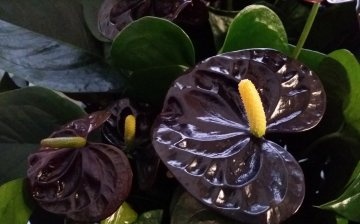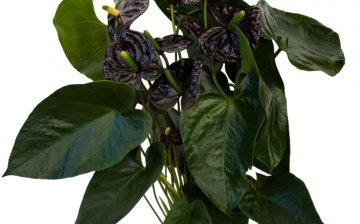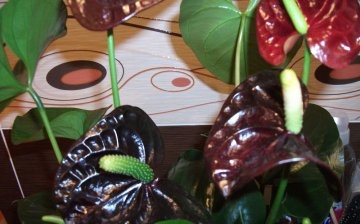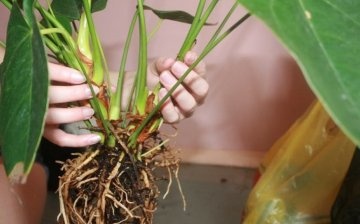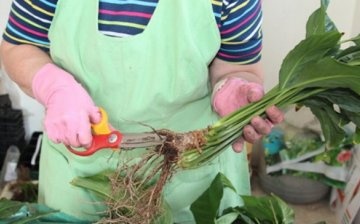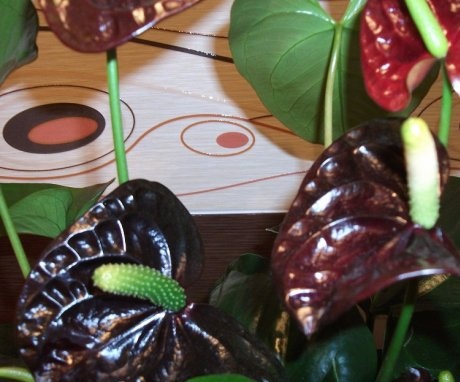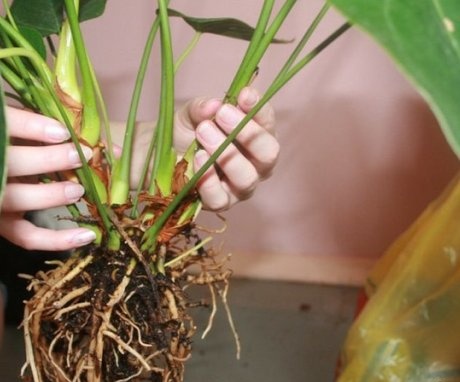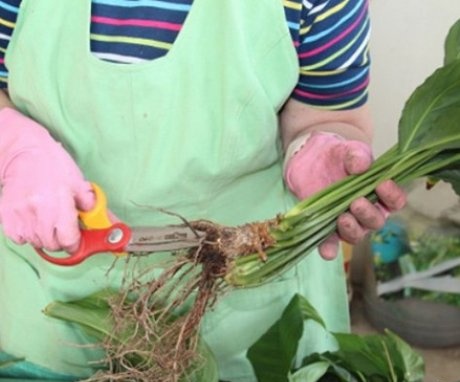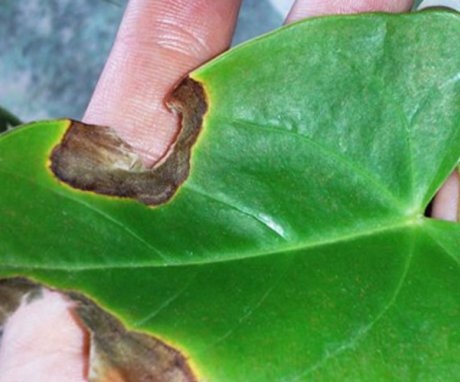How to grow Black Queen anthurium correctly?
Anthurium Is an evergreen plant that belongs to the Aroid family. About a thousand species of this plant grow in the American tropics. In our latitudes, it is grown only in a greenhouse or apartment.
Content:
- Description of the Black Queen variety
- Growing features
- All about reproduction
- Anthurium transplant
- Growing problems
Description of the Black Queen variety
All kinds anthuriumsthat are grown in the room are divided into several groups according to the color of the leaves:
- Variegated.
- With leaves of an original shape.
- Green-leaved.
Anthurium is distinguished by its original flower shape, which makes it easy to distinguish it from other plants. Its ear is wrapped in a bright shiny stipule, commonly called a flower. The stipule color can be almost any shade of red, white or even black. Rather, it is not black, but dark red.
This is how the Black Queen hybrid was created by the breeders. This is not the only variety with a dark stipule, there is also a chocolate blue one. Their names correspond to the color of the stipule.
Features of the structure of the variety:
- Black Queen leaves are green. They do not change their shade throughout the entire period of life.
- The shape of the leaves is cordate. The petiole is straight, growing vertically. Leaf length 30 cm, width 25 cm.
- Plant height reaches 80 cm. This is a tall variety of anthurium.
- Peduncles are laid in the leaf axils. When they grow, they exceed the height of the bush, towering above the leaves.
- Stipule Black Queen in the initial period of flowering is painted in a burgundy shade. Over time, it darkens, and after a while it acquires a black color with a barely noticeable reddish tint.
- The texture of the bedspread is corrugated. It is made like this by embossed veins. The flower can be up to 20 cm long.
Anthurium Black Queen has an interesting feature: flowers with stipules of two colors can appear on one bush - some black, others red. The ear looks original. At first it is white, then it takes on a greenish color. Together with a black veil, it looks not only spectacular, but also somewhat mournful. Therefore, not all growers like it. It is preferred by those who like to grow something original.
Growing features
Anthurium is grown in a soil mixture consisting of charcoal, pine bark and sawdust, sphagnum moss... You can buy it at a flower shop, choosing the soil for aroids, you can prepare it yourself. It is better to mix purchased and self-prepared soil.
A thick layer is placed in the dish below drainage... To do this, take broken brick, pebbles, pieces of foam. Lay a layer of moss on top. Cover it with soil with a level acidity pH 5.5-6.5. For its preparation, mix leafy earth, humus, peat, small pieces of fired brick, coarse sand.
How to properly care for a flower:
- Anthurium belongs to epiphytes. Under natural conditions, it is attached to another, stronger plant, which covers the anthurium from the rays of the sun. Therefore, the plant does not like to get them on the leaves and stipules.
- In order for the plant to survive at home, a certain temperature is maintained in the room. In summer, this is not a problem, because the optimum at this time will be 20-25 ° C.In winter, it is desirable to reduce 15-18 ° C. If the temperature is even lower, the plant may die. Anthurium does not like temperature fluctuations. From drafts, its leaves curl up into a tube, it may die. Therefore, it is not installed near the vents. It is better to put the flower on the west or east window, set it on a special stand away from the window.
- Anthurium is not watered very often. In summer, after 3-4 days, in winter, the period between waterings is increased to 7 days. A large amount of water is added at a time. 15 minutes after watering, drain the water from the pan to avoid root rot. The soil should not be wet. The flower is watered with filtered water at room temperature. To increase the humidity, anthurium leaves are sprayed. At the same time, they try not to fall on the stipule. Water droplets can cause light spots on them. Spraying is carried out in winter if the air in the room is dry from the central heating batteries. In the summer, they spray or wash under the shower, closing the stipule from water. If he gets under the shower, the stipules will quickly lose their appearance and die. It is possible to increase the air humidity without spraying. To do this, place a wide dish near the pot, into which water is poured. Gravel or beautiful stones are placed at the bottom of the tray. Evaporation under the influence of high temperature, water increases the humidity of the air.
- During the active growing season, the plant is fed after 2 weeks. mineral and organic fertilizerscontaining nitrogen, iron, magnesium. Fertilizers alternate among themselves. The fertilizer concentration is taken a little less than what is written in the instructions. Top dressing is needed for the formation of young leaves and buds.
During the dormant period, after flowering, the plant is watered every 10 days and is not fed, so that young leaves do not appear too early. The room temperature is lowered.
All about reproduction
Anthuriums multiply seeds, cuttings, dividing the bush, aerial roots:
- It makes no sense to grow Black Queen from seeds, because the properties of the parents are not transmitted in hybrids. But you can get new varieties. But first, plants are pollinated, waiting for the fruits to form and ripen. Collect the seeds, immediately prepare them for sowing. First, incubated for 2 hours in pink potassium permanganate solution... A layer of foam rubber is placed on the bottom of the dishes, moistened. Seeds are placed on top. Cover with glass, creating a greenhouse. Sprouted seeds are sown in loose soil, compacted, sprinkled. cover with glass. When they grow up to 7 cm, they are transplanted into new pots.
- For reproduction by division, several stems are separated during transplantation and transplanted separately.
- For propagation by cuttings, the top of one or more stems is cut off, a mixture of peat and sand is prepared and cuttings are planted there. Cover with a glass jar. Water it periodically. Remove the jar after the first young leaves appear. The first days are covered for several hours until the plant gets used to it.
- For propagation by layering, roots are taken that are closer to the soil surface. They are separated and planted in a new dish.
Anthurium transplant
Periodically, anthurium needs a transplant. But this is often not worth doing. Especially do not dramatically increase the size of the pot. In this case, the root system grows rapidly, leaves grow actively, and peduncles do not appear. Anthurium is transplanted for the first time soon after transplantation. First, the plant is given 2 weeks to adapt to new conditions.
The pot for growing anthurium Black Queen is taken wide, but not high.
This will inhibit the growth of the root system and allow flower stalks to form. Sometimes the roots after transplanting are at the soil level. In this case, cover them with wet sphagnum moss. It will protect them from drying out.
Turn the pot on its side, tap the walls and take out the plant. Examine its roots.If there are damaged or rotten ones, remove them, sprinkle the cut with crushed charcoal. The plant is placed in a pot, covered with earth at the same level as before transplanting. Sprinkle with warm water. When there are a lot of plants, you can plant several plants in one pot. This will make the bush more lush, and the number of flowers will increase.
Growing problems
When growing anthurium Black Queen, you need to carefully monitor its condition. Most often, they suffer from the following factors:
- High indoor humidity.
- Incorrect temperature conditions.
- Poorly chosen place for a flower.
- Frequent watering.
Any problems are reflected in the appearance and condition of leaves and flowers:
- Leaves turn yellow with improper watering or insufficient lighting.
- White spots appear on the leaves when the plant is kept at low temperatures. You can get rid of them by moving the plant pot to a warm place.
- If brown spots appear, they also rearrange the pot with the plant in a warm place and reduce the amount of watering and the amount of water applied.
More information can be found in the video:



